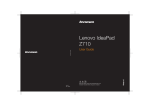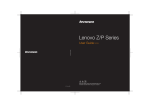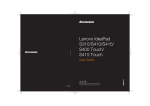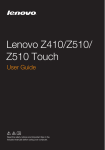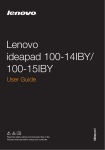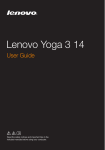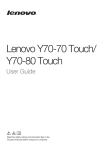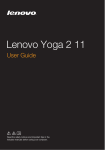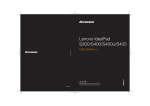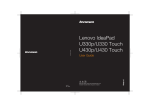Download Lenovo IdeaPad U530 Touch
Transcript
Lenovo IdeaPad U530 Touch User Guide Read the safety notices and important tips in the included manuals before using your computer. Notes • Before using the product, be sure to read Lenovo Safety and General Information Guide first. • Some instructions in this guide may assume that you are using Windows® 8. If you are using other Windows operating systems, some operations may be slightly different. If you are using other operating systems, some operations may not apply to you. • The features described in this guide are common to most models. Some features may not be available on your computer and/or your computer may include features that are not described in this user guide. • The illustrations used in this manual are for Lenovo IdeaPad U530 Touch unless otherwise stated. • The illustrations in this manual may differ from the actual product. Please refer to the actual product. Regulatory Notice • For details, refer to Guides & Manuals at http://support.lenovo.com. First Edition (June 2013) © Copyright Lenovo 2013. LIMITED AND RESTRICTED RIGHTS NOTICE: If data or software is delivered pursuant a General Services Administration “GSA” contract, use, reproduction, or disclosure is subject to restrictions set forth in Contract No. GS-35F-05925. Contents Chapter 1. Getting to know your computer .......................................... 1 Top view .......................................................................................................................1 Left‐side view ..............................................................................................................5 Right‐side view............................................................................................................8 Bottom view ...............................................................................................................11 Chapter 2. Starting to use Windows 8 ................................................ 12 Configuring the operating system for the first time ............................................12 Operating system interfaces ....................................................................................12 Charms and the charms bar.....................................................................................13 Putting the computer to sleep or shutting it down ..............................................15 Touch screen operation ...........................................................................................17 Connecting to a wireless network ..........................................................................20 Help and support ......................................................................................................21 Chapter 3. Lenovo OneKey Recovery system ................................... 22 Chapter 4. Troubleshooting ................................................................. 24 Frequently asked questions .....................................................................................24 Troubleshooting ........................................................................................................27 Trademarks............................................................................................ 31 i Chapter 1. Getting to know your computer Top view --------------------------------------------------------------------------------------------------1 2 3 7 4 6 5 Note: The dashed areas indicate parts that are not visible from outside. Attention: Do not open the display panel beyond 130 degrees. When closing the display panel, be careful not to leave pens or any other objects in between the display panel and the keyboard. Otherwise, the display panel may be damaged. 1 Chapter 1. Getting to know your computer a Integrated camera Use the camera for video communication. b Built-in microphone Captures sound, which can be used for video conferencing, voice narration, or audio recordings. c Multi-touch display The LCD display with LED backlight provides brilliant visual output. Multi‐touch function is available on this display. d Power button Press this button to turn on the computer. e Touchpad The touchpad functions as a conventional mouse. Touchpad To move the cursor on the screen, slide your fingertip over the pad in the direction in which you want the cursor to move. Touchpad buttons The functions of the left/right side correspond to those of the left/right mouse button on a conventional mouse. Notes: • You can enable/disable the touchpad by pressing F6 ( ). • If you change the HotKey Mode from Enabled to Disabled in the BIOS setup utility, you need to press the Fn key in combination with the appropriate hotkey. f Ventilation slots Dissipate internal heat. Attention: Make sure that none of the ventilation slots are blocked otherwise overheating of the computer may occur. g Wireless antennas 2 Connect to the wireless adapter to receive and send wireless signal. Chapter 1. Getting to know your computer Hotkeys You can access certain system settings quickly by pressing the appropriate hotkeys. Enables/disables Airplane mode. : Mutes/unmutes the sound. : : Decreases the volume level. : Switches the active program. : Increases the volume level. : Turns the LCD screen back‐ light on/off. : Closes the currently active window. : Projects to a connected display. : Refreshes the desktop or the currently active window. : Decreases display brightness. : Enables/disables the touchpad. : Increases display brightness. Note: If you change the HotKey Mode from Enabled to Disabled in the BIOS setup utility, you need to press the Fn key in combination with the appropriate hotkey. 3 Chapter 1. Getting to know your computer Function key combinations Through the use of the function keys, you can change operational features instantly. To use this function, press and hold Fn a ; then press one of the function keys b . 2 Insert 1 PrtSc Delete Fn The following describes the features of each function key. 4 Fn + Home: Activate the pause function. Fn + End: Activate the break function. Fn + PgUp: Enable/disable the scroll lock. Fn + PgDn: Activate the insert function. Fn + Space : Turn the keyboard backlight on/off. Home Pause End Break PgUp ScrLk PgDn SysRq Chapter 1. Getting to know your computer Left-side view -------------------------------------------------------------------------------------- 1 2 a Novo button 3 4 5 When the computer is off or in hibernation mode, press this button to start the Lenovo OneKey Recovery system or the BIOS setup utility, or to enter the boot menu. Notes: • For details, see “Chapter 3. Lenovo OneKey Recovery system” on page 22. • If your computer is preinstalled with a Linpus operating system, Onekey Recovery system is not available. b RJ-45 port Connects the computer to an Ethernet network. c HDMI port Connects to devices with HDMI input such as a TV or a display. d USB port Connects to USB devices. Notes: • The port supports USB 3.0. • For details, see “Connecting USB devices” on page 6. e Combo audio jack Connects to headsets. Notes: • At the default setting, the combo audio jack does not support conventional microphones. • The recording function may not be supported if third‐party headphones or headsets are connected, due to different industry standards. 5 Chapter 1. Getting to know your computer Connecting USB devices Connect a USB device to your computer by inserting the USB plug (Type A) into the USB port on your computer. The first time you plug a USB device into a particular USB port on your computer, Windows automatically installs a driver for that device. After the driver is installed, you can reconnect the device without performing any additional steps. Note: Typically, Windows detects a new device after connecting it, and then installs the driver automatically. However, some devices may require you to install the driver before connecting. Check the documentation provided by the device’s manufacturer before connecting the device. Before disconnecting a USB storage device, make sure your computer has finished transferring data to or from that device. Click the Safely Remove Hardware and Eject Media icon in the notification area of the Windows desktop screen to remove the device before disconnecting. Notes: • If your USB device uses a power cord, connect the device to a power source before connecting it. Otherwise, the device may not be recognized. • To connect or disconnect a USB device in sleep mode, wake up your computer first. 6 Chapter 1. Getting to know your computer Connecting a Bluetooth device If your computer has an integrated Bluetooth adapter card, it can connect to and transfer data wirelessly to or from other Bluetooth enabled devices, such as notebook computers, PDAs, and cell phones. You can transfer data between these devices at a range of up to 10 meters in open space. Note: The actual maximum range may vary due to interference and transmission barriers. For the best transfer speed, place the device as near to your computer as possible. Enabling Bluetooth and WLAN communications on your computer Press F7 ( ) to disable airplane mode. Notes: • When you do not need to use the Bluetooth function, turn it off to save battery power. • You need to pair the Bluetooth enabled device with your computer before you can transfer data between them. Read the documentation supplied with the Bluetooth enabled device for details on how to pair the device with your computer. 7 Chapter 1. Getting to know your computer Right-side view ---------------------------------------------------------------------------------- a a System status indicators Symbol 8 b c d Power indicator Battery status indicator Indicator status Meaning On (solid white) The computer is powered on. Blinking The computer is in sleep mode. Off The computer is powered off. On (solid white) The battery has more than 20% charge. Solid amber The battery has between 5% and 20% charge. Fast blinking amber There is a problem with the battery or the battery con‐ nection. Slow blinking amber The battery is being charged. When battery charge reaches 20%, the blinking color changes to white. Slow blinking white The battery has between 20% and 80% charge and is still charging. When the bat‐ tery reaches 80% charge, the light will stop blinking, but charging will continue until the battery is fully charged. Chapter 1. Getting to know your computer b Memory card slot Insert memory cards (not supplied) here. Note: For details, see “Using memory cards (not supplied)” on page 10. c USB port Connects to USB devices. For details, see “Connecting USB devices” on page 6. Note: If the battery is more than 20% charged, the USB port with a mark supports the charging of an external USB device, even when the computer is turned off. d AC power adapter jack Connects the AC power adapter. 9 Chapter 1. Getting to know your computer Using memory cards (not supplied) Your computer supports the following types of memory card: • Secure Digital (SD) card • MultiMediaCard (MMC) Notes: • Insert only one card in the slot at a time. • This card reader does not support SDIO devices (e.g., SDIO Bluetooth, etc.). Inserting a memory card To insert a memory card, do the following: 1 Push the dummy card in until you hear a click. 2 Gently pull the dummy card out of the memory card slot. Note: The dummy card is used for preventing dust and small particles from entering the inside of your computer when the memory card slot is not in use. Retain the dummy card for future use. 3 Slide a memory card in until it clicks into place. Removing a memory card To remove a memory card, do the following: 1 Push the memory card in until you hear a click. 2 Gently pull the memory card out of the memory card slot. Attention: Before removing a memory card, disable it through Safely Remove Hardware and Eject Media to avoid data corruption. 10 Chapter 1. Getting to know your computer Bottom view -----------------------------------------------------------------------------------------1 2 2 a Louvers Allow air to enter the computer for cooling. b Speakers Provide audio output. 11 Chapter 2. Starting to use Windows 8 Configuring the operating system for the first time -------------------------------------------------------------------------------------------------------------You need to configure the operating system when it is first used. The configuration process may include the procedures below: • Accepting the end user license agreement • Configuring the Internet connection • Registering the operating system • Creating a user account Operating system interfaces -------------------------------------------------Windows 8 comes with two main user interfaces: the Start screen and the Windows desktop. To switch from the Start screen to the Windows desktop, do one of the following: • Select the Desktop tile on the Start screen. • Press the Windows key + D. To switch from the desktop to the Start screen, do one of the following: • Select Start from the charms bar. • Move the cursor to the lower‐left corner, and then select the Start screen thumbnail when it is displayed. Start screen 12 Desktop Chapter 2. Starting to use Windows 8 Charms and the charms bar --------------------------------------------------Charms are navigation buttons that let you access basic tasks quickly. Charms include: Search, Share, Start, Devices, and Settings. The charms bar is the menu that contains the charms. To display the charms bar, do one of the following: • Move the cursor to the upper‐right or lower‐right corner until the charms bar is displayed. • Press the Windows key + C. • Use a finger to swipe in from the right edge of the screen until the charms bar is displayed. Search charm The Search charm is a powerful new way to find what you are looking for, including apps, settings, and files. 13 Chapter 2. Starting to use Windows 8 Share charm The Share charm lets you send links, photos, and more to your friends and social networks without leaving the app you are in. Start charm The Start charm is a quick way to go to the Start screen. Devices charm The Devices charm allows you to connect or send files to connected external devices, including digital cameras, TVs, and printers. Settings charm The Settings charm lets you perform basic tasks, such as setting the volume or shutting down the computer. Also, you can get to the Control Panel through the Settings charm when on the Desktop screen. 14 Chapter 2. Starting to use Windows 8 Putting the computer to sleep or shutting it down -----------------------------------------------------------------------------------------------------------When you have finished working with your computer, you can put it to sleep or shut it down. Putting your computer to sleep If you will be away from your computer for a short time, put the computer to sleep. When the computer is in sleep mode, you can quickly wake it to resume use, bypassing the startup process. To put the computer to sleep, do one of the following: • Close the display panel. • Press the power button. • Open the charms bar, and then select Settings Power Sleep. Attention: Wait until the power indicator light starts blinking (indicating that the computer is in sleep mode) before you move your computer. Moving your computer while the hard disk is spinning can damage the hard disk, causing loss of data. To wake up the computer, do one of the following: • Press any key on the keyboard. • Press the power button. 15 Chapter 2. Starting to use Windows 8 Shutting down the computer If you are not going to use your computer for a long time, shut it down. To shut down your computer, do the following: 1 Open the charms bar, then select Settings 2 Select Power 16 Shut down. . Chapter 2. Starting to use Windows 8 Touch screen operation ------------------------------------------------------------The display panel can accept inputs like a tablet, using the fully‐featured, multi‐touch screen; or like a traditional notebook computer, using the keyboard and touchpad. Multi-touch gestures You can touch the screen with one or more fingertips to perform a variety of tasks. Frequently used gestures Tasks performed Number of fingers used Performs an action, such as starting an app, opening a link, or performing a command. Similar to left‐clicking with a mouse. One Allows you to see detailed information before selecting an action. Can also open a menu with more options. Similar to right‐clicking with a mouse. One Tap Tap once on an item. Press and hold Press your finger down and leave it there for a moment. 17 Chapter 2. Starting to use Windows 8 (continued) Frequently used gestures Tasks performed Number of fingers used Zooms in and out on visual apps, such as pictures and maps. Can also jump to the beginning or end of a list. Two Rotating turns an object. (Note: Not all items can be rotated, depending upon the app.) Two or more Pinch Move two fingers together or apart while touching the screen. Rotate Place two or more fingers on an item and then turn your hand. Slide Drag your finger across the screen. 18 Pans or scrolls through lists and pages, but you can also use it to move an object or for drawing and writing, depending upon the app. Similar to pressing and holding to pan and to scroll with a mouse. One Chapter 2. Starting to use Windows 8 (continued) Frequently used gestures Tasks performed Number of fingers used Swipe Start from any edge of the screen, then swipe inwards toward the center. • Swiping from the top or bottom edge displays app commands, including save, edit, and delete. This also can be used to dock or close the currently open app. Similar to right‐ clicking on an app with your mouse. One • Swiping from the left displays a list of the apps currently running in the background. • Swiping from the right displays the charms. Similar to placing your mouse in the lower‐right corner of the screen. 19 Chapter 2. Starting to use Windows 8 Connecting to a wireless network ------------------------------------To connect to a wireless network, do the following: 1 Ensure airplane mode is turned off. If airplane mode is turned on, press the hotkey F7 ( ) to turn it off. 2 Open the charms bar and select Settings . A list of available wireless networks is displayed. 3 Click a network name in the list, and then click Connect. Note: Some networks require a network security key or passphrase for connection. To connect to one of those networks, ask the network administrator or the Internet service provider (ISP) for the security key or passphrase. 20 Chapter 2. Starting to use Windows 8 Help and support ---------------------------------------------------------------------------If you have questions about using the Windows operating system, refer to Windows Help and Support. To access Windows Help and Support, do one of the following: • Open the charms bar and select Settings; then select Help. • Press the Windows key + F1. Note: If hotkey mode is enabled, press the Fn key and the F1 key in combination to access the F1 key function. 21 Chapter 3. Lenovo OneKey Recovery system The Lenovo OneKey Recovery system is software designed to back up and restore your computer. You can use it to restore the system partition to its original status in case of a system failure. You can also create user backups for easy restoration as required. Note: To utilize the features of the OneKey Recovery system, your hard disk already includes a hidden partition by default to store the system image file and the OneKey Recovery system program files. This default partition is hidden for security reasons, explaining why the available disk space is less than the stated capacity. Backing up the system partition You can back up the system partition to an image file. To back up the system partition, do the following: 1 Press the Novo button to start the Lenovo OneKey Recovery system. 2 Click System Backup. 3 Select a back‐up location and click Next to start the backup. Notes: • You can choose a back‐up location on the local hard disk drive or an external storage device. • The back‐up process may take a while. • The back‐up process is only available when Windows can be started normally. Restoring You can choose to restore the system partition to its original status or to a previously created back‐up point. To restore the system partition, do the following: 1 Press the Novo button to start the Lenovo OneKey Recovery system. 2 Click System Recovery. The computer restarts to the recovery environment. 3 Follow the on‐screen instructions to restore the system partition to its original status or to a previously created back‐up point. Notes: • The recovery process is irreversible. Make sure to back up any data you wish to save on the system partition before starting the recovery process. • The recovery process may take a while. Make sure to connect the AC power adapter to your computer during the recovery process. • The above instructions should be followed when Windows can be started normally. 22 Chapter 3. Lenovo OneKey Recovery system If Windows cannot be started, follow the steps below to start the Lenovo OneKey Recovery system: 1 Shut down the computer. 2 Press the Novo button. From Novo Button Menu, select System recovery and press Enter. 23 Chapter 4. Troubleshooting Frequently asked questions -----------------------------------------------------------This section lists frequently asked questions by category. Finding information What safety precautions should I follow when using my computer? The Lenovo Safety and General Information Guide, which came with your computer, contains safety precautions for using your computer. Read and follow all the precautions when using your computer. Where can I find the hardware specifications for my computer? You can find hardware specifications for your computer on the printed flyers that came with your computer. Where can I find warranty information? For the warranty applicable to your computer, including the warranty period and type of warranty service, see the Lenovo limited warranty flyer that came with your computer. Drivers and preinstalled software Where are the installation discs for Lenovo preinstalled software (desktop software)? Your computer did not come with installation discs for Lenovo preinstalled software. If you need to reinstall preinstalled software, you can find the installation program on the D partition of your hard disk. If you cannot find the installation program there, download it from the Lenovo consumer support Web site. Where can I find drivers for my computer’s various hardware devices? If your computer is preinstalled with a Windows operating system, Lenovo provides drivers for the hardware devices that you need on the D partition of your hard disk. You can also download the latest device drivers from the Lenovo consumer support Web site. 24 Chapter 4. Troubleshooting Lenovo OneKey Recovery system Where are the recovery discs? Your computer did not come with recovery discs. Use the Lenovo OneKey Recovery system if you need to restore the system to its factory status. What can I do if the back‐up process fails? If you can start the backup but it fails during the back‐up process, try the following steps: 1 Close all open programs, and then restart the back‐up process. 2 Check to see if the destination media is damaged. Select another path and try again. When do I need to restore the system to its factory status? Restore the system when the operating system fails to start up. If there is critical data on the system partition, back it up before starting recovery. BIOS setup utility What is the BIOS setup utility? The BIOS setup utility is ROM‐based software. It communicates basic computer information and provides options for setting boot devices, security, hardware mode, and other preferences. How can I start the BIOS setup utility? To start the BIOS setup utility, do the following: 1 Shut down the computer. 2 Press the Novo button and then select BIOS Setup. How can I change the boot mode? There are two boot modes: UEFI and Legacy Support. To change the boot mode, start the BIOS setup utility and set boot mode to UEFI or Legacy support on the boot menu. 25 Chapter 4. Troubleshooting When do I need to change the boot mode? The default boot mode for your computer is UEFI mode. If you need to install a legacy operating system, such as Windows (that is, any operating system before Windows 8), Linux or DOS, etc. on your computer, you must change the boot mode to Legacy support. The legacy operating system, such as Windows, Linux or DOS, etc. cannot be installed until you change the boot mode. Getting help How can I contact the customer support center? See “Chapter 3. Getting help and service” of Lenovo Safety and General Information Guide. 26 Chapter 4. Troubleshooting Troubleshooting -------------------------------------------------------------------------------------Display problems When I turn on the computer, nothing appears on the screen. • If the screen is blank, make sure that: ‐ The AC power adapter is connected to the computer, and the power cord is plugged into a working electrical outlet. ‐ The computer power is on. (Press the power button again for confirmation.) ‐ If you are using the AC power adapter or the battery, and the battery status indicator is on, press F12 ( ) to make the screen brighter. • If these items are properly set, and the screen remains blank, take the computer for repair. When I turn on the computer, only a white cursor appears on a blank screen. • Restore backed‐up files to your Windows environment or the entire content of your hard disk to its original factory content using the Lenovo OneKey Recovery system. If you still can only see the cursor on the screen, take the computer for repair. My screen goes blank while the computer is on. • Your screen saver or power management may be enabled. Do one of the following to exit the screen saver or to resume from sleep mode: ‐ Touch the touchpad. ‐ Press any key on the keyboard. ‐ Press the power button. ‐ Press F9 ( ) to confirm whether the backlight for the LCD screen has been turned off. ‐ If the problem persists, follow the solution below in “The screen is unreadable or distorted.” The screen is unreadable or distorted. • Make sure that: ‐ The display device driver is installed correctly. ‐ The screen resolution and color quality are correctly set. ‐ The monitor type is correct. Incorrect characters appear on the screen. • Are the operating system or programs installed correctly? If they are installed and configured correctly, take the computer for repair. 27 Chapter 4. Troubleshooting BIOS password problems I forgot my password. • If you forget your user password, you must ask the system administrator to reset your user password. • If you forget your HDD password, a Lenovo authorized servicer cannot reset your password or recover data from the hard disk. You must take your computer to a Lenovo authorized servicer or a marketing representative to have the hard disk drive replaced. Proof of purchase is required, and a fee will be charged for parts and service. • If you forget your administrator password, a Lenovo authorized servicer cannot reset your password. You must take your computer to a Lenovo authorized servicer or a marketing representative to have the system board replaced. Proof of purchase is required, and a fee will be charged for parts and service. Sleep problems The critical low-battery error message appears, and the computer immediately turns off. • The battery power is getting low. Connect the AC power adapter to the computer. The computer enters sleep mode immediately after Power-on self-test (POST). • Make sure that: ‐ The battery is charged. ‐ The operating temperature is within the acceptable range. See “Chapter 2. Use and care Information” of Lenovo Safety and General Information Guide. Note: If the battery is charged and the temperature is within range, have the computer serviced. The computer does not return from sleep mode, and the computer does not work. 28 • If your computer is in sleep mode, connect the AC adapter to the computer and then press any key or the power button. • If the system still does not return from sleep mode, stops responding, or cannot be turned off, reset the computer. Unsaved data may be lost. To reset the computer, press and hold the power button for four seconds or more. Chapter 4. Troubleshooting Sound problems No sound can be heard from the speaker even when the volume is turned up. • Make sure that: ‐ The mute function is off. ‐ The combo audio jack is not in use. ‐ The speaker is selected as the playback device. Battery problems Your computer shuts down before the battery status indicator shows empty. -orYour computer operates after the battery status indicator shows empty. • Discharge and recharge the battery. The computer does not operate with a fully charged battery. • The surge protector in the battery might be active. Turn off the computer for one minute to reset the protector; then turn on the computer again. A hard disk drive problem The hard disk drive does not work. • In the Boot menu in the BIOS setup utility, make sure that the hard disk drive is included in the EFI list. OneKey Recovery system problems Backup cannot be made. • You are not currently using a Windows operating system. • There is not enough space to store the backed up data. You need to free more hard disk space on your backup partition. Failure to restore the system partition to its factory default. • The system partition, such as the partition size or the drive capacity has been modified. Touch screen problem The touch screen reacts, but not where you are touching it. • If you cannot select objects accurately with your finger, you need to calibrate the touch screen.Select Hardware and Sound in the control panel, select Tablet PC Settings. Click Calibrate in the Tablet PC Settings dialog box. 29 Chapter 4. Troubleshooting The touch screen does not respond. • Make sure the touch screen is clean • Make sure your computer not crash. If your computer does not respond, do one of the following: ‐ To turn off your computer, press and hold the power button for four seconds or more. If the computer still does not respond, remove the AC power adapter. ‐ Disable the sleep timer when you are working on the network. Other problems Your computer does not respond. • To turn off your computer, press and hold the power button for four seconds or more. If the computer still does not respond, remove the AC power adapter. • Your computer might lock when it enters sleep mode during a communication operation. Disable the sleep timer when you are working on the network. I need to start the computer from a connected device, but the device does not appear on the boot device list. • Check the boot mode setting in the BIOS setup utility. If Boot Mode is set to UEFI, make sure that the device or the medium in the device supports UEFI boot. If the device or the medium in the device does not support UEFI boot, set Boot Mode to Legacy Support. If the device still does not appear in the boot device list, replace with a new device or medium. The connected external device does not work. • Do not connect or disconnect any external device cables other than USB while the computer power is on; otherwise, you might damage your computer. • When using a high power consumption external device, such as an external USB optical disk drive, use an external device power adapter. Otherwise, the device may not be recognized, or system shut down may result. 30 Trademarks The following terms are trademarks or registered trademarks of Lenovo in the United States, other countries, or both. Lenovo IdeaPad OneKey VeriFace Microsoft and Windows are trademarks of Microsoft Corporation in the United States, other countries, or both. Other company, products, or service names may be trademarks or service marks of others. 31 ©Lenovo China 2013 en-US Rev. AA00






































